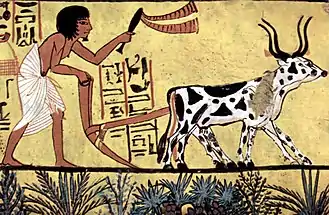Jellabiya
The jellabiya, also jalabiya[1] or galabeya (Arabic: جلابية / ALA-LC: jilabīyah Egyptian Arabic: [ɡæ.læ.ˈbej.jæ, ɡæl.læ-]; "jelebeeya" in Ethiopia; "jehllubeeya" in Eritrea) is a loose-fitting, traditional Egyptian garment from the Nile Valley, also traditionally worn in Sudan[2] and Eritrea. The Egyptian style is more colorful[3] and is worn by both men and women.


The jellabiya differs from the Arabic thawb, as it has a wider cut, no collar (in some cases, no buttons) and longer, wider sleeves. Versions for farmers have very wide sleeves and sewn-in pockets used to carry tobacco, money, or other small items. Along the Red Sea coast in Egypt, Nubia and Sudan and among some Beja tribesmen, the Arabic dishdash is preferred due to the jellabiya's association with farming.
Jellabiya worn in summer are often white. During winter, thicker fabrics that are grey, dark green, olive, blue, tan or striped are used, and colorful scarves are worn around the neck. The garment is traditionally worn with an ammama (turban).
References
- Kushkush, Isma'il (September 2020). "In the Land of Kush". Smithsonian Magazine. Smithsonian Institution. Retrieved January 19, 2021.
- Perner, Conradin (2017-03-15). Why Did You Come If You Leave Again?: The Narrative of an Ethnographer’S Footprints Among the Anyuak in South Sudan. Xlibris Corporation. ISBN 978-1-5245-7187-0.
- Challen, Paul (2015-07-15). The Culture and Crafts of Egypt. The Rosen Publishing Group, Inc. p. 22. ISBN 978-1-4994-1157-7.
| Agriculture |
|---|
 |
|
|
.svg.png.webp)